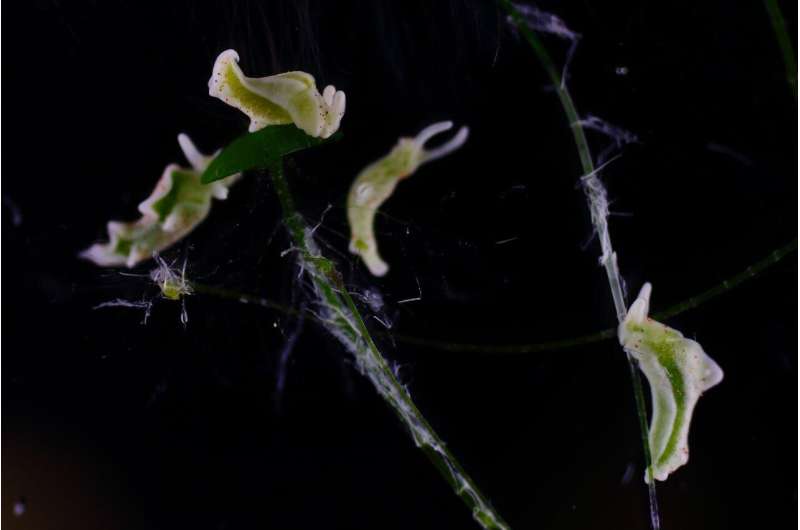How some sea slugs keep their ability to carry out plant-like photosynthesis

Scientists have shed new light on a relationship between a sea slug and tiny structures called chloroplasts from their food algae that allow the animals to photosynthesise in a similar way to plants.
The findings, originally posted on bioRxiv and published today in eLife, add to our understanding of this animal-chloroplast relationship and photosynthetic animals more widely.
The sea slug Elysia timida (E. timida) is typically found living in shallow Mediterranean waters. Similarly to plants, these organisms are able to photosynthesise, meaning they can use sunlight to produce sugar from carbon dioxide and water. The process is enabled by chloroplasts from the alga Acetabularia acetabulum that the sea slugs feed on.
"These stolen chloroplasts are located in the slugs' digestive tract cells and remain functional for a long time, but little is known about this peculiar animal-chloroplast relationship," explains lead author Vesa Havurinne, Doctoral Student in Molecular Plant Biology at the University of Turku, Finland. "One question concerns the dual nature of light. Light is necessary to drive photosynthesis, but at the same time causes continuous damage to the chloroplasts. How do the slugs protect the chloroplasts from this damage?"
To answer this question, Havurinne and senior author Esa Tyystjärvi, Teacher in Molecular Plant Biology at the University of Turku, used methods such as chlorophyll fluorescence to compare the process of photosynthesis in a large continuous culture of E. timida sea slugs and their prey alga Acetabularia acetabulum grown in the lab. Their results showed that living inside the slugs changes the interior of the chloroplasts in a way that reduces damage to them caused by light.
The team identified three protection mechanisms. First, when exposed to light, slug chloroplasts switch on a mechanism that efficiently converts light energy to heat. Next, the chloroplasts maintain a photosynthetic electron transfer chain in a neutral, oxidized state. This chain then allows the chloroplasts to perform photosynthesis within the slugs, while relying on safe energy 'sinks' such as flavodiiron proteins to accept excess electrons.
"Our results suggest that these photoprotective mechanisms contribute to the long-term functionality of chloroplasts inside the sea slugs, shedding light on this fascinating biological phenomenon," Tyystjärvi says. "This work may also help us better understand occurrences of similar relationships between organisms from earlier in evolution."
He adds that chloroplasts stolen from food algae may impact the longevity of sea slugs. The team's next steps will involve looking at how the intrinsic properties of the chloroplasts affect their lifespan inside E. timida and other slug species.
More information: Vesa Havurinne et al, Photosynthetic sea slugs induce protective changes to the light reactions of the chloroplasts they steal from algae, eLife (2020). DOI: 10.7554/eLife.57389
Journal information: eLife
Provided by eLife




















